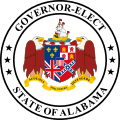Third reading
Once the bill has been discussed, each member casts his or her vote as their name is called alphabetically. Since the state's Senate is rather small, voting may be done effectively in that house via manual roll call. An electronic voting machine is utilized in the House of Representatives.
If amendments are adopted, the bill is sent to the Enrolling and Engrossing Department of that house for engrossment. Engrossment is the process of incorporating amendments into the bill before transmittal to the second house.
Conference committees
A conference committee is empaneled to discusses the points of difference between the two houses' versions of the same bill, and tries to reach an agreement between them so that the identical bill can be passed by both houses.
When a bill has passed both houses in identical form, it is enrolled. The "enrolled" copy is the official bill, which, after it becomes law, is kept by the Secretary of State for reference in the event of any dispute as to its exact language. The bill is then ready for transmittal to the Governor.
Presentation to the governor
The governor may sign legislation, which completes its enactment into law. From this point, the bill becomes an act, and remains the law of the state unless repealed by legislative action, or overturned by a court decision. The governor may veto legislation to express disapproval of the bill. In the event of a veto, the governor returns the bill to the house in which it originated, with a message explaining his objections and suggesting any amendments (if applicable) which might remove those objections. The bill is then reconsidered, and if a simple majority of the members of both houses agrees to the proposed executive amendments, it is returned to the Governor, as revised, for a signature.
On the other hand, a simple majority of the members of each house can choose to approve a vetoed bill precisely as the Legislature originally passed it, in which case it becomes a law over the governor's veto. This is in contrast to the practice in most states and the federal government, which require a two-thirds majority in both houses to override a governor's veto.
If the Governor fails to return a bill to the legislative house in which it originated within six days after it was presented (not including Sundays), it becomes a law without their signature. This return can be prevented by recession of the Legislature. In that case the bill must be returned within two days after the legislature reassembles, or it becomes a law without the Governor's signature.
The bills that reach the Governor less than five days before the end of the session may be approved by him within ten days after adjournment. The bills not approved within that time do not become law. This is known as a "pocket veto". This is the most conclusive form of veto, for the Legislature (having adjourned) has no chance to reconsider the vetoed measure.
Alabama is one of the states in which the governor has the power to accept or reject any particular item of an appropriation bill without vetoing the entire bill. In this event, only the vetoed item of the appropriation bill is returned to the house of origin for reconsideration by the Legislature. The remainder of the bill becomes law. Alabama's laws are compiled and published in the Code of Alabama after their codification.






















